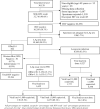Recent HIV infection among pregnant women in the 2017 antenatal sentinel cross-sectional survey, South Africa: Assay-based incidence measurement
- PMID: 33852629
- PMCID: PMC8046194
- DOI: 10.1371/journal.pone.0249953
Recent HIV infection among pregnant women in the 2017 antenatal sentinel cross-sectional survey, South Africa: Assay-based incidence measurement
Abstract
Introduction: New HIV infection during pre-conception and pregnancy is a significant contributor of mother-to-child transmission of HIV in South Africa. This study estimated HIV incidence (defined as new infection within the last one year from the time of the survey which included both new infections occurred during pregnancy or just before pregnancy) among pregnant women and described the characteristics of recently infected pregnant women at national level.
Methods: Between 1 October and 15 November 2017, we conducted a national cross-sectional survey among pregnant women aged 15-49 years old attending antenatal care at 1,595 public facilities. Blood specimens were collected from pregnant women and tested for HIV in a centralised laboratory. Plasma viral load and Limiting Antigen Avidity Enzyme Immunosorbent Assay (LAg) tests were further performed on HIV positive specimens to differentiate between recent and long-term infections. Recent infection was defined as infection that occurred within one year from the date of collection of blood specimen for the survey. Data on age, age of partner, and marital status were collected through interviews. Women whose specimens were classified as recent by LAg assay and with viral loads >1,000 copies/mL were considered as recently infected. The calculated proportion of HIV positive women with recent infection was adjusted for assay-specific parameters to estimate annual incidence. Survey multinomial logistic regression was used to examine factors associated with being recently infected using HIV negative women as a reference group. Age-disparate relationship was defined as having a partner 5 or more years older.
Results: Of 10,049 HIV positive participants with LAg and viral load data, 1.4% (136) were identified as recently infected. The annual HIV incidence was 1.5% (95% confidence interval (CI): 1.2-1.7). In multivariable analyses, being single (adjusted odds ratio, aOR: 3.4, 95% CI: 1.8-6.2) or cohabiting (aOR: 3.8, 95% CI: 1.8-7.7), compared to being married as well as being in an age-disparate relationship among young women (aOR: 3.1, 95% CI: 2.0-4.7; reference group: young women (15-24years) whose partners were not 5 years or more older) were associated with higher odds of recent infection.
Conclusions: Compared to previous studies among pregnant women, the incidence estimated in this study was substantially lower. However, the UNAIDS target to reduce incidence by 75% by 2020 (which is equivalent to reducing incidence to <1%) has not been met. The implementation of HIV prevention and treatment interventions should be intensified, targeting young women engaged in age-disparate relationship and unmarried women to fast track progress towards the UNAIDS target.
Conflict of interest statement
As an inventor of LAg-Avidity EIA, BP receives royalties from the licensing agreement with commercial partners as per policy of the U.S. Government. This doesn’t alter adherence to PLOS ONE policies on sharing data and materials. There are no other competing interests.
Figures
References
-
- Centers for Disease Control and Prevention and Association of Public Health Laboratories. Laboratory testing for the diagnosis of HIV infection: updated recommendations, 2014 [cited: 08/07/18]. Available from: https://stacks.cdc.gov/view/cdc/23447.
-
- UNAIDS. Progress towards Start free Stay free, AIDS free targets, 2020 report [cited 15/12/20]. Available from: https://www.unaids.org/en/resources/documents/2020/start-free-stay-free-....
-
- Dinh TH, Delaney KP, Goga A, Jackson D, Lombard C, Woldesenbet S, et al.. Correction: Impact of Maternal HIV Seroconversion during Pregnancy on Early Mother to Child Transmission of HIV (MTCT) Measured at 4–8 Weeks Postpartum in South Africa 2011–2012: A National Population-Based Evaluation. PLoS One. 2015;10(6):e0130321. 10.1371/journal.pone.0130321 - DOI - PMC - PubMed
Publication types
MeSH terms
Grants and funding
LinkOut - more resources
Full Text Sources
Other Literature Sources
Medical
Miscellaneous




